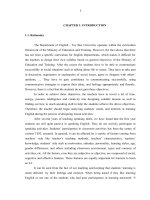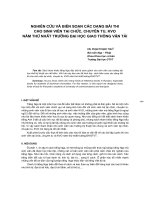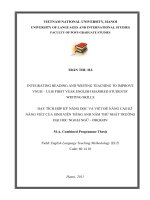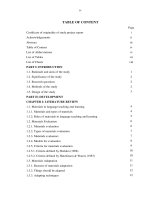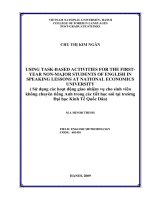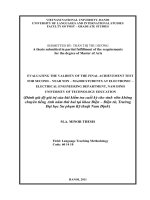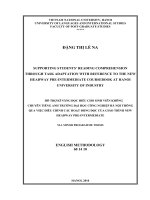Đánh giá giáo trình New English File Pre-intermediate dành cho sinh viên không chuyên Tiếng Anh năm thứ nhất Trường Đại học Khoa Học Xã Hội và Nhân Văn những
Bạn đang xem bản rút gọn của tài liệu. Xem và tải ngay bản đầy đủ của tài liệu tại đây (1.14 MB, 18 trang )
VIETNAM NATIONAL UNIVERSITY, HANOI
UNIVERSITY OF LANGUAGES AND INTERNATIONAL STUDIES
FACULTY OF POST GRADUATE STUDIES
AN EVALUATION OF THE TEXT BOOK
ENGLISH FILE PRE-INTERMEDIATE FOR THE
FIRST YEAR NON-ENGLISH MAJORED STUDENTS
AT UNIVERSITY OF SOCIAL SCIENCES AND
HUMANITIES; SUGGESTIONS FOR BOOK USE AND
ADAPTATION
(-
Tnh
x)
MINOR PROGRAM THESIS
FIELD: ENGLISH TEACHING METHODOLOGY
CODE: 601410
VIETNAM NATIONAL UNIVERSITY, HANOI
UNIVERSITY OF LANGUAGES AND INTERNATIONAL STUDIES
FACULTY OF POST GRADUATE STUDIES
ENGLISH FILE PRE-INTERMEDIATE FOR THE
FIRST YEAR NON-ENGLISH MAJORED STUDENTS
AT UNIVERSITY OF SOCIAL SCIENCES AND
HUMANITIES; SUGGESTIONS FOR BOOK USE AND
ADAPTATION
(-
x)
MINOR PROGRAM THESIS
FIELD: ENGLISH TEACHING METHODOLOGY
CODE: 601410
, M.A.
iv
TABLE OF CONTENTS
Declaration i
Acknowledgements ii
Abstract iii
Table of contents iv
List of abbreviations viii
List of figures and tables viii
PART A: INTRODUCTION……………………………………………………….
1
1. Rationale for the thesis ……………………………………………………………
1
2. Aims of the thesis …………………………………………………………………
1
3. The significance of the thesis……………………………………………………….
2
4. Scope of the thesis…………………………………………………………………
2
5. Methods of the study………………………………………………………………
2
6. Design of the study…………………………………………………………………
3
PART B: DEVELOPMENT………………………………………………………
4
CHAPTER 1: LITERATURE REVIEW………………………………………….
4
1.1. Text book, coursebook and materials………………………………………….
4
1.1.1. Definitions ………………………………………………………………………………
4
1.1.2. The roles of Course-book ……………………………………………………………
5
1.2. Materials evaluation……………………………………………………………
6
1.2.1. Definition ……………………………………………………………………
6
1.2.2. Purposes of materials evaluation and the importance of materials evaluation
7
1.2.2.1. Purposes………………………………………………………………………………
7
v
1.2.2.2. The importance……………………………………………………………………….
7
1.2.3. Types of materials evaluation………………………………………………….
7
1.2.4. Material evaluators ……………………………………………………………
8
1.2.5. Models for Materials evaluation ………………………………………………
9
1.2.5.1. Evaluation by Ellis (1997)………………………………………………………….
9
1.2.5.2. Evaluation by McDonough and Shaw (1993)……………………………………
10
1.2.5.3. Evaluation by Hutchinson and Water (1987) ……………………………………
10
1.2.6. Criteria for Materials evaluation………………………………………………
11
1.2.7. Need analysis………………………………………………………………….
14
1.2.8. Materials adaptation…………………………………………………………
16
1.3. Suitability of the present study in the research area………………………….
18
CHAPTER 2: RESEARCH METHODOLOGY………………………………….
20
2.1. Description of the context……………………………………………………….
20
2.1.1. The setting……………………………………………………………………………….
20
2.1.2. Course material…………………………………………………………………………
21
2.1 3. Course objectives……………………………………………………………………….
23
2.1.4. Course assessment……………………………………………………………………
23
2.2. Research methodology …………………………………………………………
23
2.2.1. Subjects …………………………………………………………………………………
23
2.2.2. Instruments ……………………………………………………………………………
23
2.2.3. Methods and procedures ………………………………………………………………
24
CHAPTER 3: DATA ANALYSIS AND RESULTS DISCUSSION……………
26
vi
3.1. Data analysis …………………………………………………………………….
26
3.1.1. Overall rating of the course book New English File pre-intermediate…………
26
3.1.2.Teachers’ and students’ preference of the course book New English File pre –
intermediate…………………………………………………………………………………….
26
3.1.3. What teachers and students do not like about the book……………………………
27
3.1.4. The decision to choose the book for future use……………………………………
27
3.1.5. Does the material provide students with the opportunity to develop their
communicative competence?
27
3.1.6. The language points available in this material……………………………………
28
3.1.7.The participants’ opinions about language skills in the book New English File
pre-intermediate……………………………………………………………………………….
29
3.1.8. What do you think about the topics in this material?
30
3.1.9. The update information of the book ………………………………………………
30
3.1.10. Class time ……………………………………………………………………………
31
3.1.11. Teachers and students’ preferences for the topics in New English File pre-
intermediate……………………………………………………………………………………
31
3.1.12. Teachers’ suggestions for the materials improvement ………………………….
32
3.2. Summary of major findings ……………………………………………………
34
3.3. Recommendation for future material improvements ………………………
35
3.3.1. Why teachers have to adapt the book …………………………………………
35
3.3.2. Adaptation Techniques………………………………………………………
36
3.3.2.1. Addition………………………………………………………………………………
36
3.3.2.2. Deletion ……………………………………………………………………………….
36
3.3.2.3. Replacement ………………………………………………………………………….
36
vii
3.3.2.4. Reorder or combination……………………………………………………………
36
PART C: CONCLUSION……………………………………………………………
38
1. The Conclusion of the study………………………………………………….
38
2. Limitation and suggestions for future research……………………………….
39
REFERENCES………………………………………………………………………
41
APPENDICE…………………………………………………………………………
I
Appendix 1…………………………………………………………………………….
I
Appendix 2……………………………………………………………………………
VI
Appendix 3…………………………………………………………………………….
VII
Appendix 4…………………………………………………………………………….
XIII
Appendix 5…………………………………………………………………………….
XVIII
Appendix 6……………………………………………………………………………
XXI
Appendix 7…………………………………………………………………………….
XXVII
viii
LIST OF ABBREVIATIONS
USSH
University of Social Sciences and
Humanities
HULIS
Hanoi University of Languages and
International studies
Ss
Students
Ts
Teachers
VNU
Vietnam National University
ix
LIST OF FIGURES AND TABLES
No
Title
Page
Figure 1
Materials Evaluation Model of McDonough and Shaw ( 1993, p.75)
10
Figure 2
Materials Evaluation Process (Hutchinson and Waters 1987, p98)
10
Figure 3
Teachers’ and students’ assessment of the book New English File- pre
intermediate
26
Figure 4
Teachers’ and students’ opinions about the topics in New English File
pre-intermediate
30
Figure 5
Participants’ opinions about the update of the topics in New English
File – pre intermediate
30
Table 1
Teachers’ and students’ opinions of the language point available in the
book New English File pre-intermediate
28
Table 2
Teachers and students’ viewpoints about the language skills in New
English File pre-intermediate
29
Table 3
Teachers and students’ thought of class time each week
31
Table 4
Teachers and students’ preferences for the topics in New English File
pre-intermediate
31
1
The summary of the thesis
PART I: INTRODUCTION
1. Rationale of the study
There are many reasons why I conducted this thesis. Firstly, learning English
successfully including: teachers, suitable course book choice, learning objectives, and
environment and among which, choosing an effective course book is always related to the
objectives defined. How to evaluate the course book so that we know whether our aims
are well- matched with the chosen book or not is really a demanding task. Secondly, there
has been a big change in the choice of English course book at University of Foreign
Languages an International Studies, Vietnam National University, Hanoi since 2010.
Two years ago, I taught New Way A- the third edition. But since 2010, I have taught
them New English File – from elementary to pre-intermediate, and intermediate. Thirdly,
with the growth of computer- assisted language learning, students have an access to many
sources of learning materials. It is essential that teachers make use of the assessment tools
to evaluate materials so that their students can have an opportunity to learn the highest
quality books providing students both communicative competence and diverse learning
experience. Last but not least, it is true that teachers teach students to learn English best
when teachers have profound knowledge of their students’ needs an interests.
For all- above reasons, I will choose my minor thesis “ An Evaluation of New English
file – pre- intermediate for the first year non- English majored students at University
of Social Sciences and Humanities; Suggestions for book use and adaptation”
2. Aims of the thesis
The primary goal of this thesis is to evaluate the textbook New English File pre-
intermediate from both lecturers and students’ viewpoints and then investigate the ways
teachers adapt the book so that the book meets students’ needs and interests. To achieve
the aims of the thesis, the following research questions are proposed.
(a) To what extent does New English File Pre-intermediate satisfy students’ needs and
interests?
2
(b) What improvements should be made to the material to meet the students’ needs and
interests?
3. The significance of the thesis
The results of the thesis will provide useful information not only for the researcher, the
course books designers but also for the teaching staff and the first- year non- English
major students at University of Social Sciences and humanities. In addition, the findings
are regarded as the bases for recommendations of teaching New English File series more
successful. Last but not least, the research results are hoped to make small contribution to
the field of materials evaluation.
4. Scope of the thesis
At the present, a set of New English File is being taught at University of Social Sciences
and Humanities. The researcher, who is in charge of teaching New English File pre-
intermediate, teaches the first year students. That is the reason why the thesis will firstly
focus on evaluating the post use of course book New English File – pre-intermediate.
Secondly, due to the limit of the minor thesis, the course book will be evaluated in terms
of language providing and skills developing.
5. Methods of the study
According to research type, this thesis is categorized as an action research. To support the
research with varied and valid data, the author combined both qualitative and quantitative
approaches. As the study deals with two questions: (1) To what extent does New English
File Pre-intermediate satisfy students’ needs? ; (2) What improvements should be made
to the material to meet students’ needs? The following methods will be employed to
collect data for the study:
Survey – questionnaires: Two sets of questionnaires on New English File pre-
intermediate evaluation designed for both teachers and the first –year students who have
experienced using the book
6. Design of the study
The study is divided into three parts: the Introduction, the Development and the
Conclusion.
Part A: INTRODUCTION
Part B: DEVELOPMENT – consists of three chapters
3
Chapter 1: Literature review
Chapter 2: Methodology
Chapter 3: Data analysis and results discussions
Part C: CONCLUSION
PART II: DEVELOPMENT
CHAPTER 1: LITERATURE REVIEW
1.1. Text book, coursebook and materials
1.1.1. Definitions
1.1.2. The roles of Course-book
1.2. Materials evaluation
1.2.1. Definition
1.2.2. Purposes of materials evaluation and the importance of materials evaluation
1.2.2.1. Purposes
1.2.2.2. The importance
1.2.3. Types of materials evaluation
1.2.4. Material evaluators
1.2.5. Models for Materials evaluation
1.2.5.1. Evaluation by Ellis (1997)
1.2.5.2. Evaluation by McDonough and Shaw (1993)
1.2.6. Criteria for Materials evaluation
1.2.7 Need analysis
1.2.8. Materials adaptation
1.3. Suitability of the present study in the research area
It is necessary to clarify how the present study fits into the area of investigation. Firstly,
with the real teaching context, the researcher found it vital not only to assess the New
English File so that learners can make the best of the book but also enable teachers to
apply the best methods. Therefore, in this thesis, the writer assesses the book whether it is
suitable for the learners or not. Secondly, from two years’ teaching experience, the
4
researcher has found the significance of adapting the book to make the learners feel
motivated as well as learner- friendly.
In brief, the study is supposed to enhance the context of the learning and teaching New
English File for English department at the pre-intermediate level at University of Social
Sciences and Humanities.
CHAPTER 2: RESEARCH METHODOLOGY
2.1. Description of the context
2.1.1. The setting
The study was conducted at University of Social Sciences and Humanities that
trains a variety of students’ majors such as tourists guides, journalists, librarians
and teachers. There are many foreign languages like English, French, Chinese,
Japanese, and Korean. Among which English is a compulsory subject with 13
credits at University of Social Sciences and Humanities and it has the biggest
learners though most students are not majored in English. In the first year, they
learn New English file elementary and New English file pre-intermediate. In the
second year, they learn New English File intermediate. In the third year, they do
not have to study English except high quality students. The high quality students
learn ILETS for one fifteen week semester. As soon as they finish their semester,
they take the ILETS exams. As for normal classes, they are not going to take any
English exams in the fourth year. Each academic year falls into two semesters,
each lasting 15 weeks, and finishing with end of term examinations. For the first
two years, which means the first four semesters, students are taught basic language
skills namely listening, speaking, reading, writing and grammar. They learn each
level in four semesters of the first two years. During fifteen weeks of each New
English File, the course is organized in two meetings a week, each 25 – student
class has to attend four hours of English a day. In each meeting, teacher teaches
listening, reading, writing, speaking, and grammar integratedly. The teaching and
learning New English File series follow the learner- center approach, aiming at
5
developing students’ English communicative competence. Usually three or four
English teachers are responsible for a class with different backgrounds of students.
2.1.2. Course material
2.1 3. Course objectives
2.1.4. Course assessment
2.2. Research methodology
2.2.1. Subjects
The subjects involved in this study were 200 first year non English majors and 20
English teachers. The research is carried out on only the first year students of
school year 2010- 2011. Among them, only samples of the students are randomly
picked up. They include both male and female students but the female
outnumbered the male, ranging from the age of 18 to 22. Most of them learned
English for seven years. However, they have different levels of English
proficiency because they come from different places in Vietnam with different
background knowledge. The students under study have finished their first term
and second term of the first year at USSH. Therefore, they are supposed to be at
pre-intermediate level of English proficiency. Regarding English teachers, most
of them have had more than one year in teaching New English File at English
department. All of them have B.A degree while five of them have M.A degree in
Education or linguistics. The teachers who have graduated are studying MA
courses or preparing to learn MA course in the future. The teachers here are the
samples of the teacher population who have been working actively with the
material.
2.2.2. Instruments
2.2.3. Methods and procedures
CHAPTER 3: DATA ANALYSIS AND RESULTS DISCUSSION
3.1. Data analysis
For the first research question: To what extent does New English File Pre-
intermediate satisfy students’ needs and interests?
6
Most teachers and students share the view that the book has satisfied both teachers and
students’ needs and interests in terms of language points and language skills, the various
topics and activities. However, the book has not had any room for learning strategies
which students need to improve their learning methods.
For the second research question: What improvements should be made to the material
to meet the students’ needs and interests?
First of all, teachers should find ways to discover students’ needs and interests. In fact, it
is a hard job for teachers because of different preferences; we can do small things like
chatting, exchanging common email addresses, small talks or break chats and conduct a
survey and expectation settings in which we listen to what our students want as well as
what they expect from us. By doing these, we can discover our students’ personality,
hobbies and learning styles.
Secondly, the topics of the materials should be more practical and suitable and various
for students’ preferences, ages and backgrounds. As a result, students find these topics
familiar and motivated to get involved.
Thirdly, learning strategies are one of the most factors helping the first year students
study well. However, the course book truly does not introduce the skills. Therefore,
teachers give students learning strategies by delivering students handouts with clear and
necessary tips and exercises compatible with the taught skills. It is advisable that teachers
share their learning strategies or introduce students to authentic websites so that students
get used to learning strategies in their major in general and English in particular.
Last but not least, in terms of methodology including learning vocabulary and grammar
and four skills and teachers’ roles. For grammar and vocabulary acquisition, teachers can
provide students with more handouts of grammar and vocabulary suitable for students’
levels. For four skills, in general, teachers share the view that we apply three stages for
each skill: pre, while and post. Thanks to that, the first year students have a more
profound view of what they learn. In particular, with regard to speaking teachers should
organize more group activities and redesign the tasks to motivate students to get
involved in the lesson without shyness or unwillingness and passiveness. Also, to help
students speak more naturally and fluently teachers had better provide them with
7
language functions. Sometimes teachers can combine both reading and speaking with the
consultation of other same topic sources like Streamline or Headway A, B, C to diversify
the speaking activities in the book. For reading, teachers should be selective. This means
that teachers choose the most interesting and most important text to teach, which helps
teachers teach actively and develop their students’ significant words in each file. In
addition, besides teaching students reading skills, teachers help students learn word forms
in different contexts and turn passive word learning into dynamic use of word. For
listening, it works best when students are given time to read the instructions carefully and
know what to do with the type of listening. To do this, teachers try to ask students how
they deal with each category and supply them with full guidelines. Sometimes, providing
some extra listening like songs, funny conversations or same games really helps students
feel interested in mastering listening. For writing, teachers should firstly provide students
samples that are more interesting and analyze the text, and then require students to write
in pair, in group and individual. Along with the good book, teachers play the most
important part in deciding students’ success. Thus, teachers should be selective, active
and flexible. We select the most important parts which are closely related to students to
teach students and show different roles sometimes as a friend, a teacher or even a family
member to create friendly teacher- students relationship. We should not be greedy to
cover anything. By doing this, students feel tired and get nothing. Moreover, we are to be
active and enthusiastic and passionate so that our students feel motivated and happy to
learn.
Besides the above suggestions, teachers who get involved in the study would like to support
others. Firstly, Teachers expected that students will have more possible accesses to learn
English like cable TV, internet rooms. Secondly, University of Social Sciences and
Humanities hold a month – orientation which equips students with essential learning skills
such as teamwork, language skills and university learning. Thirdly, instruction and
assessment should be closely linked. Fourthly, students are required to master New English
File from elementary before they learn Pre-intermediate. Last but not least, class size and
their English proficiency should be compatible so that teachers make the best use of
classroom and facilities like radios, projectors.
8
PART C: CONCLUSIONS
1. Summary of the study
Material plays an important part in the English learning and teaching process. The
findings from materials evaluation enable the classroom teachers and education
programmers to determine whether the materials are best- suited for a particular context.
A majority of materials are evaluated to not only address the strengths and weaknesses
of the materials and but also make recommendations for the future materials
improvement.
The course book “New English File pre-intermediate” currently employed for the first
year students of USSH has been gauged based on the model and criteria evaluation
suggested by Hutchinson and Waters (1993). From the detailed data analysis in the
previous chapter, the writer can reach some conclusions for two research questions raised
earlier.
The material “New English File Pre-intermediate” has satisfied students’ needs and interests
as it offers students a variety of activities to develop their communicative competences.
However, the materials have failed to give students learning strategies and more chances to
practice writing, pronunciation, and vocabulary.
The thesis is fulfilled with the author’ endless efforts. The author does hope that it could
make a small contribution to the more effective learning, teaching of New English Pre-
intermediate in particular, and New English series in general. However, shortcomings are
unavoidable. She strongly recommends further study on the issues raised to bring a
prefect picture of the context and would be grateful to get any comments from the
readers.
1. motivate students to enjoy writing journal as stated by White and Amdt (1991, p.67
quoted in Luu Trong Tuan 2010, p.83), “This technique has been found to be an effective and
productive means of arousing interest in writing, which, at the same time, develops fluency
of expression. It also helps students to become aware of why they wish to communicate their
ideas and to regard writing not only as a means of personal expression, but also a dialogue in
written language with the reader.” Moreover when correcting students’ writing, teachers
should give them a writing checklist so that they are aware of their self- correction. For
learning vocabulary, students learn best when they are taught the most important words
9
appearing many times in each unit. To enrich new words, teachers should give vocabulary
handouts compatible with the lessons’ topics as well as hold funny games or role-plays so
that students get involved and remember better. In addition, final for pronunciation, teachers
choose the most important ones in each file and choose other supplementary sources to make
the lesson more interesting and practical.
2. Basing on the results of the thesis, the researchers suggests some possible methods of
material adaptation by applying techniques of addition, deletion, replacement, and
reorder and combination for better material teaching.
2. Limitation and suggestions for future research
Within the scale and limited scope of a minor thesis, this study does have some certain
limitations. Firstly, as the researcher has only focused on general evaluation of the
Course book New English File pre-intermediate based on students’ needs and interests, it
may not give the reader the whole picture of the context. Be well aware of these, the
author has used data triangulation such as questionnaires and interviews and teacher’s
weekly self report to guarantee the validity of the research.
As discussed earlier in the scope of the study, this study is limited to evaluate the book
New English File pre-intermediate out of students’ needs and interests. The findings
presented above are just a modest contribution in the process of teaching and learning
New English File series. The evaluation of the set of these books should be investigated
more, especially in four separated skills and language points. More specifically, the
following aspects need further research: evaluation of New English File series teaching
and learning in terms of Learner- centeredness, a vocabulary evaluation, four skills
evaluation, and pronunciation evaluation.
PDF Merger
Thank you for evaluating AnyBizSoft PDF
Merger! To remove this page, please
register your program!
Go to Purchase Now>>
Merge multiple PDF files into one
Select page range of PDF to merge
Select specific page(s) to merge
Extract page(s) from different PDF
files and merge into one
AnyBizSoft
